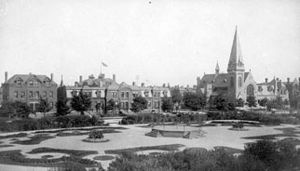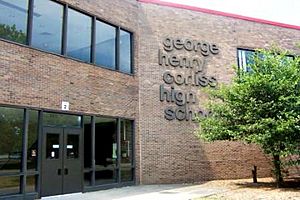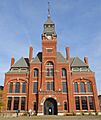Pullman, Chicago facts for kids
Quick facts for kids
Pullman
|
|
|---|---|
| Community Area 50 - Pullman | |
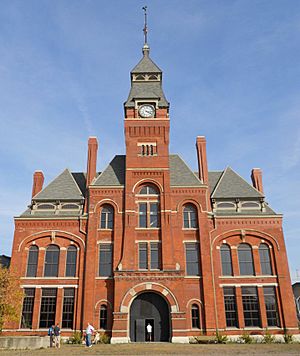
The former Pullman Clock Tower and Administration Building, opened as the Pullman National Monument Visitor Center in September 2021.
|
|
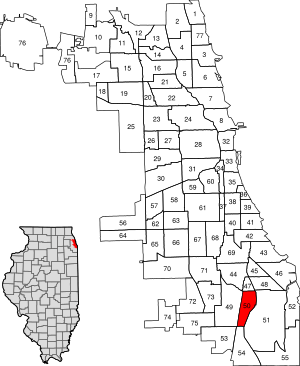
Location within the city of Chicago
|
|
| Country | United States |
| State | Illinois |
| County | Cook |
| City | Chicago |
| Named for | George Pullman |
| Neighborhoods |
list
Cottage Grove Heights
Pullman Kensington |
| Area | |
| • Total | 2.11 sq mi (5.46 km2) |
| Population
(2020)
|
|
| • Total | 6,820 |
| • Density | 3,235/sq mi (1,249.1/km2) |
| Demographics 2020 | |
| • White | 6.5% |
| • Black | 83.6% |
| • Hispanic | 7.2% |
| • Asian | 0.1% |
| • Other | 2.6% |
| Time zone | UTC-6 (CST) |
| • Summer (DST) | UTC-5 (CDT) |
| ZIP Codes |
parts of 60628
|
| Median household income | $43,539 |
| Source: U.S. Census, Record Information Services | |
Pullman is a historic neighborhood located on the South Side of Chicago. It is one of Chicago's 77 official community areas. Pullman is about 12 miles from downtown Chicago and sits next to Lake Calumet.
The name "Pullman" refers to a larger area, but it's most famous for its two historic parts. The older part is known simply as "Pullman" and is a special Chicago Landmark district and a national historical park. The newer northern part is called "North Pullman." The original town built by the Pullman Company is located between 103rd Street and 115th Street, bordered by railroad tracks to the east and Cottage Grove to the west.
Since the late 1900s, people in Pullman have been working to improve the neighborhood. Many residents are fixing up their homes and helping with projects all over the area. You can even take walking tours to explore historic Pullman.
Pullman is home to many old and beautiful buildings. These include the Hotel Florence, the Clock Tower and Factory, and Greenstone Church. The Arcade Building, which was also famous, was unfortunately destroyed in the 1920s. Nearby, in the Kensington neighborhood, you can find the former St. Salomea church. This church was built in the unique Polish Cathedral style and is now used by Salem Baptist Church.
Pullman was even nominated as one of the "Illinois Seven Wonders" in a state contest!
Contents
History of Pullman
How Pullman Began
Historic Pullman was built in the 1880s by a man named George Pullman. He owned the Pullman Palace Car Company, which made fancy railroad cars. He built this town specifically for his workers to live in. Workers who lived there had to follow certain rules and pay rent.
George Pullman's architect, Solon Spencer Beman, was very proud that he designed a town that met all the workers' needs. The houses were comfortable for their time. They even had modern features like indoor plumbing, gas, and sewers.
The Pullman Strike
In 1893, there was a big economic downturn called the Panic of 1893. This meant fewer people were buying Pullman cars. The Pullman Company had to lay off many workers. They also changed how others were paid, reducing their total income. Even with these pay cuts, the company did not lower the rent for workers living in the town of Pullman.
Because of this, workers started the Pullman Strike in 1894. This strike lasted for two months. It became so serious that the U.S. government and military had to get involved. A special group called the Strike Commission later said that while the town looked nice, it didn't help the workers financially.
Becoming Part of Chicago
George Pullman died in 1897. After his death, a court in Illinois ruled that the company had to sell the town. This was because running a town was not part of the company's main business. So, in 1899, the town of Pullman and other parts of the South Side became part of the city of Chicago. Within ten years, Chicago sold the houses to the people who lived in them.
After the strike, Pullman slowly became a regular Chicago neighborhood. It was still known for its special Victorian architecture. However, the neighborhood's success continued to depend on the Pullman Company for many years.
Changes Over Time
Starting in the 1950s, many jobs were lost in Chicago as industries and railroads changed. This caused the Pullman neighborhood to decline. People started moving to newer homes in the suburbs. In 1960, there was a plan to tear down the original town of Pullman to build an industrial park.
But the residents formed the Pullman Civic Organization. They worked hard and convinced the city to save their community. The neighborhood's population reached its highest point in 1970.
Pullman's Revival
By 1972, the Pullman Historic District was recognized as a special landmark. It received national, state, and city protection. This helped save the original 900 rowhouses and public buildings that George Pullman had built.
- It became a National Historic Landmark District in 1969.
- It was listed on the National Register of Historic Places.
- In 1970, it was named a State landmark by the Illinois Historic Preservation Agency.
- In 1972, South Pullman was declared a City of Chicago Landmark.
To keep the historic look of the area, Chicago has rules for new buildings and renovations. These rules are explained in the Beman Committee's Homeowner's Guide. The committee is named after Solon Spencer Beman, Pullman's first architect.
In February 2015, President Obama named the district the Pullman National Monument. In December 2022, it became a national historical park.
Pullman's Population
| Historical population | |||
|---|---|---|---|
| Census | Pop. | %± | |
| 1930 | 6,705 | — | |
| 1940 | 6,523 | −2.7% | |
| 1950 | 8,899 | 36.4% | |
| 1960 | 8,412 | −5.5% | |
| 1970 | 10,965 | 30.3% | |
| 1980 | 10,341 | −5.7% | |
| 1990 | 9,344 | −9.6% | |
| 2000 | 8,921 | −4.5% | |
| 2010 | 7,325 | −17.9% | |
| 2020 | 6,820 | −6.9% | |
The Pullman community area is mostly made up of African American residents. Many residents are older. However, the different neighborhoods within Pullman have different populations.
In June 2017, there were about 6,501 people living in Pullman. About 82.8% of the people were African American, and 7.1% were White. About 8.5% of the population identified as Hispanic or Latino. The median age in Pullman was 40 years old. This is older than the average age for the whole city of Chicago, which was 33 years.
For example, the historic Pullman neighborhood itself is about 29% White and 31% African American. About 36% of its 1,422 residents are Hispanic or Latino. In contrast, North Pullman is 96% African American. And Cottage Grove Heights is 98% African American.
Pullman in Movies and TV
Pullman has been a setting for several movies and TV shows.
- The movie Road to Perdition, starring Tom Hanks, was filmed in historic Pullman. It showed the old factory and how it looked with workers.
- The 1993 film The Fugitive also had scenes in Pullman. Harrison Ford was filmed in a local bar, running down an alley, and even across the tops of Pullman houses.
- In 2007, Universal Studios filmed The Express: The Ernie Davis Story in Pullman.
The architecture of Pullman even inspired parts of The Polar Express. The North Pole scenes, including the building where Santa Claus appears, were based on Pullman buildings. The movie's director, Robert Zemeckis, grew up near Pullman in the Roseland neighborhood.
In 2006, the TV show National Open House on HGTV featured a historic Pullman house.
Getting Around Pullman
Pullman has two train stations for the Metra Electric Line:
- Kensington/115th Street station
- Pullman/111th Street station
Most express trains stop at the 115th Street station. Only local trains stop at the 111th Street station.
Famous People from Pullman
- Robert Fioretti: He was a member of the Chicago City Council from 2007 to 2015. He was born in Pullman.
- Mark Konkol: A journalist who won a Pulitzer Prize for Local Reporting in 2011. He lived in Pullman in 2007.
- Darrell Walker: A professional basketball player who went to school in Pullman.
Education in Pullman
Pullman is part of the City of Chicago School District #299. It is also part of the City Colleges of Chicago District #508.
Children in Pullman attend these elementary schools:
- Schmid Elementary School
- Wendell Smith Elementary School
- Edgar Allan Poe Classical School
- George M. Pullman School
Most high school students in Pullman go to Corliss High School, which is located in Pullman. Some students in the northeastern part of the area go to Harlan Community Academy High School in nearby Chatham.
The main campus of Olive-Harvey College, which is part of the City Colleges of Chicago system, is also located in Pullman.
Images for kids


